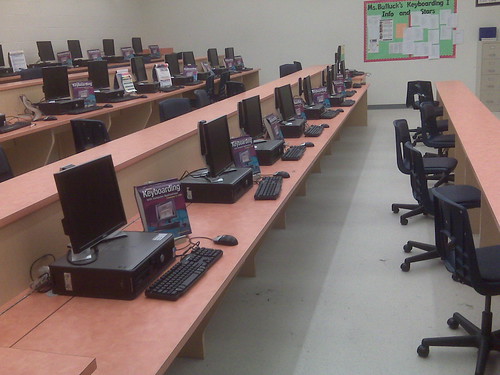Tastes great? Less filling? Meh?
In my poor monitoring of my rss feed and twitter, I missed this whole back and forth that’s one of those periodic conflicts that come up on the edublogosphere about “real teachers” vs. “ed tech types”. It sorta peaked in Lee Kolbert’s post I’m Not Who You Think I Am, but there are others out there related to it. It’s a classic argument about teaching rules and compliance vs. child/student autonomy. I’m not going to rehash all the arguments here. Instead, I offer it up as background for some of my thinking about the issue of compliance vs. autonomy as the school year starts.
The older I get, and the more I teach, the less useful I find black and white statements about what teaching should look like to be. I’ll dust off my favorite statement from Richard Allington, yet again, good teaching is about constant monitoring and adjustment. One-size fits all, fits no-one, and here is today’s example…
One of the issues that came up in that discussion was about how to arrange students in the classroom. I think that we all sometimes make snap judgments about what a “good” classrooms looks like that don’t have a lot to do with reality. I once worked with a teacher who had a class with some of the more jacked up line behavior that I’ve seen in my time. He also had great test scores (moved one kid up two score bands), AND had a really great classroom culture that he built over time by looping with his kids from fourth up to sixth grade. The kids did literature units at the time the district was pushing the pacing guide for the language arts text down teachers’ throats. If you judged him on his lines (which many outsiders, administrators, AND fellow teacher tend to do) you’d think his class was a train wreck. It wasn’t. He just didn’t care enough about kids “lining up” to bother. And, since the kids didn’t end up in conflicts, or hurting each other, did it really matter? When I’d see those lines, I’d remember a quote from a training I attended where the trainer hit on a really good point when he said, some of the scariest classrooms he’d seen were in inner-city schools and were perfectly silent, but no learning was going on, showing that “neat lines” and “quiet classes” are not an end all.
I’ve always striven to have just enough compliance and control to keep the kids safe. The reality is that we are cramming kids and teachers into really small spaces. The cubicle farms adults work in are palatial compared to the desk space most upper elementary (33-35 per class) and secondary (30-40 per class) students get. That same school with the awesome teacher of the horrid lines, also had another teacher who was very crunchy granola on the outside, but had a lot unstated behavioral expectations that were largely unmet. The teacher insisted on having sixth graders sit at table groups. When faced with classes where that did not work, the teacher insisted that this was essential. It’s amazing how many teachers have iron-clad notions of student/desk arrangement that they will not part with, even when they aren’t working.
My own experience illustrates both my theory that we often assume, and why you have to approach each class differently. In my early teaching days I put students in groups of individual student desks. This was mostly because I couldn’t get tables, only desks, so I put them “together”. I then moved to teaching “behavior” students. I thought I was being smart not putting them in groups, but had arranged the desks in a horseshoe formation with me at the end. I thought it would be great because I would see everyone. The behavioral consultant pointed out that the arrangement allowed an unparalleled opportunity for students to make inadvertent eye-contact with each other, which in that particular population led no-where productive, and usually resulted in a fight. I then moved students to staggered rows, so they had to work to make eye-contact with fellow students. I’ve never done that pattern since except during state testing when I’m supposed to keep students from seeing each others tests.
When I left that assignment for a regular classroom, I had students in un-staggered rows the first year, and by the next year, I had kids back in groups. If I’m in a regular classroom (as opposed to the lab where I now teach), I still prefer individual desks for kids. I feel this gives the most flexibility, since I can put them together in groups, or take them apart as needed. I don’t like tables. That is my bias. They are not flexible. I think that a number of kids have a hard time figure out the “borders” of their space, and this leads to unnecessary conflicts. I have seen teachers who made them work. I’ve seen more teachers who thought they could make it work, and ended up pounding their heads against a metaphorical wall in proving their point about student cooperation, but as I say that is my bias.
It’s funny how these biases work. I have a lot of people come into my lab and think it’s a great space. I’m sure it looks nice and “cooperative”, with its three islands of computers. It’s horrid for anything but having kids on computers. It’s better than a lot of labs which have machines along all the walls, making it impossible for at least one wall of students to see projected images from the teacher computer. It’s good in the sense that it is so direct instruction hostile, that I have to make what little I do, really count, and be well-done. It really doesn’t facilitate group work by the kids. At most, they can do a pair-share, but groups of more than three are about impossible, and the kids have to work to talk to each other. I will not even describe the management headache that that blind corner in the front right is. I think a lab that has rows of computer tables, but chairs that could move around would be much conducive to group work.
Something like this would be better:

But it’s in those dratted rows so it couldn’t possibly be progressive, right?
Photo Credit: The Art Guy on flickr




